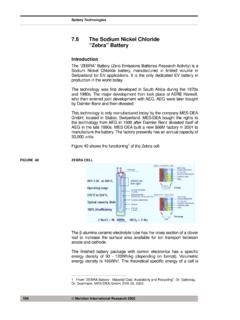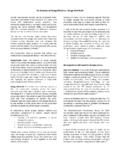Transcription of The Trouble with Lithium 2 - Meridian International Research
1 The Trouble with Lithium 2 Under the Microscope Meridian International ResearchLes Legers27210 MartainvilleFranceTel: +33 2 32 42 95 49 Fax: +33 2 32 41 39 9829th May 2008 Copyright Meridian International Research , 2008. All rights reserved. Meridian International Research 2008 i Contents 1 Executive Summary 1 2 Current Production Resources 3 The Lithium Triangle 3 Salar de Atacama 4 Geological Structure 5 Conclusion 10 Salar de Hombre Muerto 11 Salar de Uyuni 11 Geological Structure 13 Production Potential 14 Environmental Factors 15 Conclusion 16 Salar del Rincon 17 Other Brine Resources 20 Clayton Valley 20 China 20 Salar del Olaroz 21 Mineral Resources 21 Western Australia - Greenbushes 21 North Carolina 22
2 Other Producing Resources 23 Zimbabwe 23 Russian Federation 23 Portugal 24 Canada 24 Brazil 24 Conclusion 24 ii Meridian International Research 2008 Contents 3 Future Potential Resources 25 Introduction 25 Mineral Resources 25 Osterbotten, Finland 25 China, Jiajika 26 Democratic Republic of the Congo (Zaire) 26 Hectorite Clays 26 Brines 27 Searles Lake 27 Great Salt Lake 28 Salton Sea 28 Smackover Oilfield Brines, Arkansas 32 Bonneville Salt Flats, Utah 33 Dead Sea 34 Other Chilean/ Argentinian/ Bolivian Salars 34 China 35 Seawater 35 4 Production and Market Factors 39 Introduction 39 Lithium Carbonate Production 40 China 41 Other Areas 41 Current Lithium Market Factors 42 Existing Market Demand 42 Market Projection Scenarios 43 Production of Battery Grade ( )
3 Lithium Carbonate 46 Production Factors 46 Battery Recycling 47 Conclusion 48 5 The Wider Environment 49 Geopolitical Environment 49 Nuclear Fusion 51 Environmental and EcologicalFactors 52 6 Conclusion 53 Meridian International Research 2008 1 1 Executive Summary This report analyses recently published 1 revisions to Lithium Reserves,analyses realistic Lithium Carbonate production potential from existingand future Lithium resources and discusses major factors of increasingimportance in the development of future Lithium production for theAutomotive main conclusions are as follows: 1.
4 This report confirms our previous assessment 2 that realistically achievable Lithium Carbonate production will be sufficient for only a small fraction of future PHEV and EV global market requirements, that demand from the portable electronics sector will absorb much of the planned production increases in the next decade and that other battery technologies that use unconstrained resources should be developed for the mass automotive market. 2. This report shows that the major economically recoverable Lithium Brine Reserves are lower than previously estimated at only 4 million tonnes of Lithium .
5 3. This report confirms that mass production of Lithium Carbonate is not environmentally sound, it will cause irreparable ecological damage to ecosystems that should be protected and that LiIon propulsion is incompatible with the notion of the Green Car . 4. This report confirms that the highly focused geographical concentration of Lithium production will exacerbate the already strained geopolitical relations between Latin America and the USA. The recent paper An Abundance of Lithium catalogues numerousLithium deposits. It includes a wide spectrum of deposits in which theconcentration of Lithium varies from a low of 8 ppm to 3,000 ppm ormore in some parts of the Andes.
6 Total Global Lithium Reserves of 28million tonnes are postulated in comparison with a Reserve Baseestimated by the USGS to be 11 million tonnes. 1. An Abundance of Lithium , Whitepaper, RK Evans, 20082. The Trouble with Lithium : Implications of Future PHEV Production for Lithium Demand, MIR, 2006. 2 Meridian International Research 2008 Executive Summary The document is not useful for the industrial and strategic planningpurposes of the battery and automotive industries. It confoundsgeological Lithium deposits of all grades and types with economicallyviable Reserves that can be realistically exploited and relied upon as adependable source of sustainable supply by the mass production scaleof the automotive industry.
7 Many of the deposits catalogued cannot beconsidered to be actual or potential Lithium Reserves. They would havehigher production costs and lower production rates than the SouthAmerican and Chinese brine deposits, coupled with unproven andheretofore undeveloped such nebulous resources were excluded from our previous analysis The Trouble with Lithium for these reasons. In fact, more thoroughconsideration of the Salar de Atacama and Salar de Uyuni show thatglobal recoverable Lithium reserves are only in the order of 4 cite the opening lines of the Handbook of Lithium and NaturalCalcium by Donald Garrett 3 : Lithium is a comparatively rare element, although it is found in manyrocks and some brines, but always in very low concentrations.
8 Thereare a fairly large number of both Lithium mineral and brine deposits butonly comparatively a few of them are of actual or potential commercialvalue. Many are very small, others are too low in grade . This statement summarises the nature of Lithium deposits. A simplecatalogue of geological Lithium deposits cannot be used to estimaterealistic potential and achievable Lithium production. In the presentreport, we analyse the main Lithium Reserves, Reserve Bases as wellas the major deposits that are not of economic value to illustrate thepotential Lithium Carbonate production that could realistically beexpected over the next 12 is our conclusion that total Chemical Grade Lithium Carbonateproduction is unlikely to exceed 200,000 tonnes per year before of high purity ( )
9 Battery Grade Lithium Carbonate asrequired for Electric Vehicles will be significantly existing demand from the portable electronics sector for Carbonate continues to grow at the current rate of 25% perannum, by 2015 if optimum production increases occur, there will beonly 30,000 tonnes of Chemical Grade Lithium Carbonate available tothe Automotive Industry (including from Chinese sources). This wouldbe sufficient for less than million GM Volt type vehicles worldwide. 3. Handbook of Lithium and Natural Calcium, Donald E.
10 Garrett, Academic Press, 2004 Meridian International Research 2008 3 2 Current Production Resources Lithium Triangle Some 70 percent of the world s economic Lithium deposits (ReserveBase) are found in one small location on the Earth - the Lithium Trianglewhere the borders of Chile, Bolivia and Argentina meet. It is bounded bythe 3 Salars of the Salar de Atacama, the Salar de Uyuni and the Salarde Hombre Muerto. FIGURE 1 THE Lithium TRIANGLE 4 Meridian International Research 2008 Current Production Resources The Lithium Triangle has sides of approximately 360km, 280km and560km in length.












